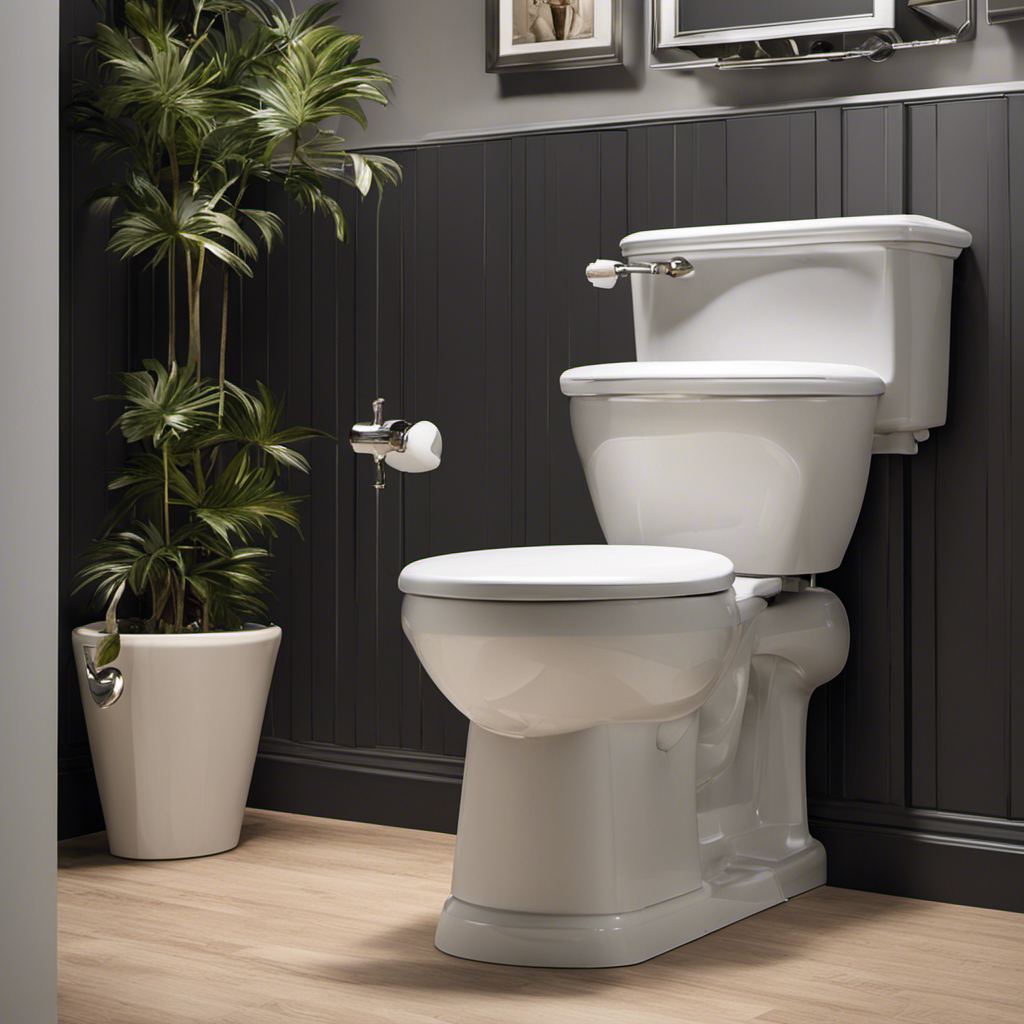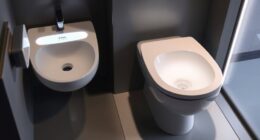I’ve seen it happen countless times – the dreaded toilet overflow. It’s a messy situation that no one wants to deal with.
But have you ever wondered what actually causes a toilet to overflow? In this article, we’ll dive into the common plumbing issues that can lead to this unfortunate event.
From blockages in the toilet drain to malfunctioning floats or fill valves, we’ll explore the technical reasons behind this frustrating problem.
Get ready to become a toilet troubleshooting expert!
Key Takeaways
- Faulty float valve or fill valve can cause continuous water flow and overflow in a toilet.
- Clogs in the toilet drain, caused by excessive paper usage or flushing foreign objects, can lead to overflow.
- Sediment buildup in the float or fill valve can cause malfunction and potential overflow.
- Regular cleaning and maintenance of the toilet’s float and fill valves can help prevent overflows.
Common Plumbing Issues
One of the most common plumbing issues is a toilet overflowing due to a clog. As a professional plumber, I have encountered this problem countless times.
In addition to clogs, other common plumbing issues include leaky faucets and low water pressure. Leaky faucets can waste a significant amount of water and lead to higher water bills. They are often caused by worn-out washers or seals.
Low water pressure, on the other hand, can be caused by various factors such as mineral buildup in pipes, a malfunctioning pressure regulator, or a problem with the municipal water supply.
Properly diagnosing and addressing these issues requires a thorough understanding of plumbing systems and the expertise to implement effective solutions.
Blockages in the Toilet Drain
If a blockage is present in the toilet drain, it can lead to an overflow. Blockages can occur due to various reasons, such as excessive paper usage, foreign objects being flushed, or a buildup of waste and debris over time. When a blockage occurs, it is important to address it promptly to prevent further damage and potential flooding.
Two common tools used to remove blockages are toilet plungers and toilet augers. Toilet plungers are designed to create pressure and suction to dislodge the blockage. They work by creating a seal around the drain and then pushing and pulling to create a vacuum effect, loosening the clog. Toilet augers, on the other hand, are long and flexible tools that can reach deeper into the drain to break up and remove the blockage.
Using these tools correctly can often resolve minor blockages and prevent toilet overflows. However, if the blockage persists or if you are unsure about using these tools, it is advisable to seek professional help.
Transition: While blockages in the toilet drain are a common cause of overflows, another potential culprit is a malfunctioning float or fill valve.
Malfunctioning Float or Fill Valve
To prevent further issues, check if the float or fill valve in your toilet is functioning properly. The float valve controls the water level inside the tank, while the fill valve regulates the flow of water into the tank. If either of these components is faulty, it can lead to an overflow.
Here are four common problems that can occur with the float or fill valve:
-
Faulty Float Valve: If the float valve is not shutting off properly, it can cause the water to continuously fill the tank, resulting in an overflow.
-
Stuck Fill Valve: A fill valve that is stuck open can lead to excessive water entering the tank, causing it to overflow.
-
Water Supply Issues: A faulty water supply line or a closed valve can result in inadequate water pressure, preventing the fill valve from properly refilling the tank.
-
Sediment Buildup: Over time, sediment can accumulate in the float or fill valve, causing them to malfunction and potentially causing an overflow.
Regularly checking and maintaining these components can help prevent toilet overflows caused by malfunctioning float or fill valves.
Clogged Vent Pipes
Check if there is a clog in your vent pipes, as this can lead to issues with the proper ventilation of your plumbing system. Vent pipe clogs are a common cause of toilet venting problems, which can result in toilets overflowing. Vent pipes are vertical pipes that extend from the plumbing system to the roof of a building, allowing air to flow in and out, maintaining the balance of pressure in the system. When these pipes become clogged with debris such as leaves, bird nests, or even ice during winter, it restricts the airflow and disrupts the proper functioning of the plumbing system. This can lead to a buildup of pressure, causing toilets to overflow. Regular maintenance and cleaning of vent pipes are essential to prevent these clogs and ensure the proper ventilation of your plumbing system.
| Common Causes of Vent Pipe Clogs | Prevention Tips |
|---|---|
| Accumulation of debris | Regular cleaning |
| Bird nests | Install bird guards |
| Ice during winter | Insulate pipes |
| Tree branches or leaves | Trim trees nearby |
| Poor installation or design | Seek professional help |
Sewer Line Problems
Are you experiencing any issues with your sewer line? It’s important to be aware of the signs of sewer line damage and to properly maintain your sewer line to prevent further issues. Here are some key points to consider:
-
Slow draining: If you notice that your sinks, showers, or toilets are draining slowly, it could be a sign of a clogged sewer line.
-
Foul odor: A persistent foul smell around your property, especially near drains or in the yard, could indicate a sewer line problem.
-
Backups: If wastewater starts to back up into your sinks, showers, or toilets, it’s a clear indication that there’s a blockage or damage in your sewer line.
-
Water pooling: Excess water pooling in your yard, especially near the sewer line, could be a sign of a leak or breakage.
Regular sewer line maintenance and addressing any signs of damage promptly can help prevent costly repairs and ensure the proper functioning of your sewer system.
Conclusion
Well, it seems like we’ve reached the end of our journey through the world of toilet overflows. Who would have thought that such a simple fixture could cause such chaos? From blockages in the drain to malfunctioning float valves, there are a multitude of reasons why our porcelain thrones can turn against us.
And let’s not forget about those clogged vent pipes and sewer line problems that can make our lives even more… interesting. So, next time you find yourself knee-deep in toilet troubles, just remember, it’s all part of life’s little ironic twists.










